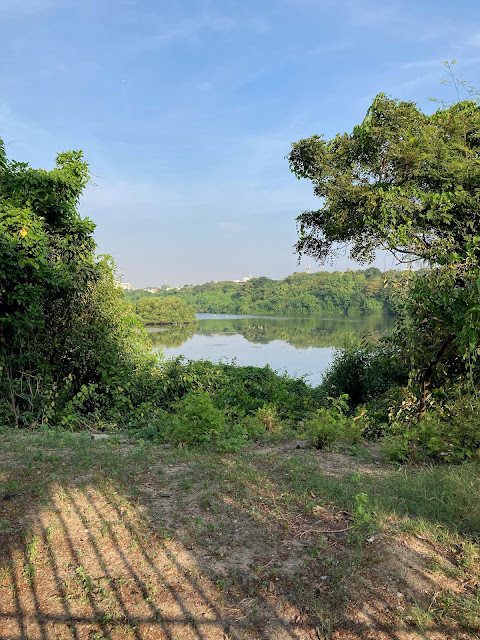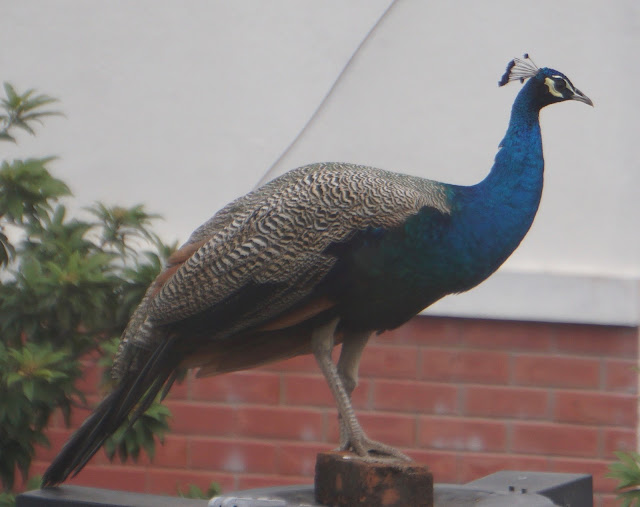Tuesday, March 8, 2022
A Dugong reserve announced
Saturday, March 5, 2022
Adyar Poonga from the outside
11th to 13th February 2022
Day 1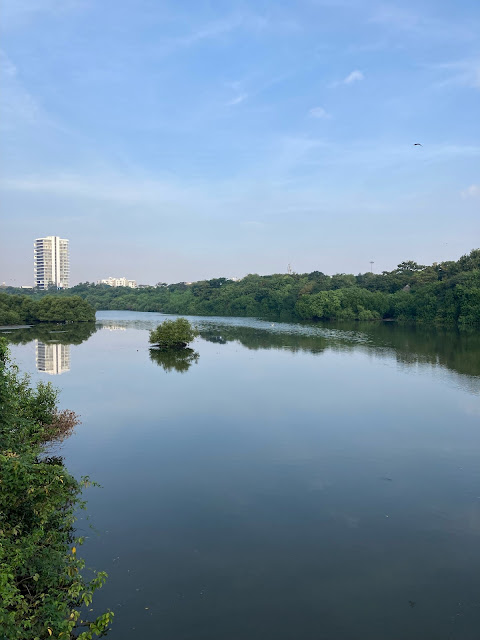 |
| I enjoyed the breeze, the call of the white-browed bulbuls, the flight of the little egret over the water's surface, instead. |
 |
| A couple of Night Herons were busy in their own focussed worlds. |
 |
| I spied the Poonga walking paths |
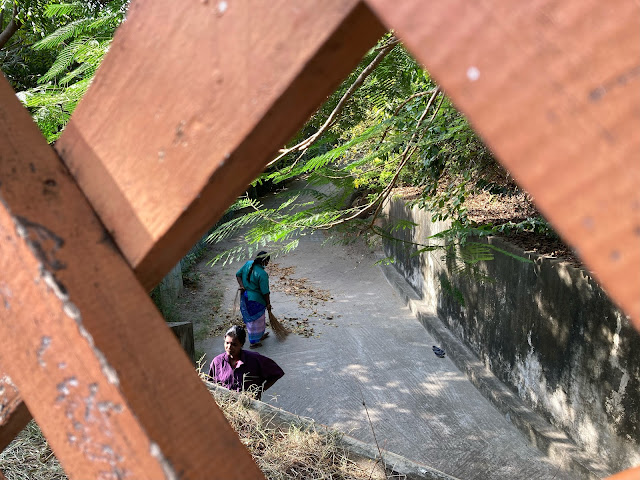 |
| And the workers going about their work, sweeping and cleaning the paths. Squirrels enjoyed the trellis racing up and down, and getting startled seeing my face suddenly. |
 |
| At the edge, I could hear the loud cackling of white-breasted waterhens, among the reeds at the water's edge, while a pelican paddled away from me. |
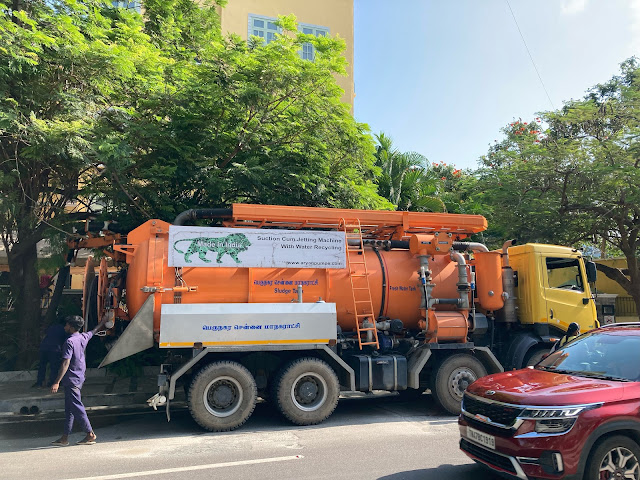 |
| As I crossed the kalyana mangalam, I saw this sewage truck that had the Made in India lion - a recycling sewage tank is it? |
 |
| I walked back via Quibble cemetery, wandered through the ancient graves, and saw a large blooming Kapok |
 |
| 14th Feb saw the BWS on the backwaters, and I managed to get on decent binocs-phone-cam shot |
 |
The interconnectedness of it all
Sunday, February 13, 2022
A Jacana start to my birding year
5th January 2022
My first birding outing of the year with Umesh and Srinivas. They picked me up before 6 am, and with masks, binoculars and water, we went down OMR to explore(for me first time ) the rear of the Perumbakkam water body, close to where the International Village School is located.
As we wound through the roads of the colony that is well, developing in marshland, there was much muttering and exclaiming from Srinivas and Umesh, as they remarked how even more plots have gone, and walls have come up where there was none before. Habitat loss in front of our eyes.
 |
| We reached the border of the lake at around 615, and dawn was just breaking. |
There was nothing much by way of water bird life here - the water was deep - and so we moved further west, where we could see the edge of the marsh.
 |
| Open-billed storks also were in plenty, flying overhead in formation |
As we scanned the marsh, Umesh and I argued about the difference between a pylon, post and pillar. If you are wondering why, he grumbled that I was misdirecting him by wrongly misidentifying these important markers, here he was staring at the pillar when I should have been saying post, etc etc. (Not that he missed anything, he was "just saying". )
 |
| A purple heron greatly improved the drab concrete scenery |
The complete list from this Classic Farms side is here, compiled methodically by Srinivas, down to the last wagtail.
We drove back to the familiar northern side of the lake after this. A road that was familiar to me two years ago, when we used to bring the NIFT students on a nature walk.
 |
| This was a favourite spot, always, with cormorants, kingfishers and pelicans, which would usually delight the students. This time also, the shrub was full of activity. |
There were Northern Pintails everywhere - swimming in the waters, preening on the edge of the lake and sunning and sleeping further up on the banks.
We drove a bit further down and caught a meditating purple heron, and a Pipit walking on the wall/bund.
 |
| Blue-tailed bee-eaters delighted us with their aerial swoops as they caught insects and came back to their perch. |
 |
| Look at the colours! |
Complete list of the lake northern front here.
We then drove into the ELCOT area, where more surprises awaited me. Last time during the bird race, we had walked in, only to be stopped by the guards, who were not very impressed with our birding activity. However, going in, in a car, is perfectly acceptable it seems. So in we went, and stopped near the water-filled plot, which I hope will not be developed.
 |
| A Little Egret seemed to pose for us, its breeding plumage fluttering in the breeze, its yellow feet clearly seen |
A bunch of Fulvous Whistling Ducks first caught our eye, paddling in the water, behind the egret.
 |
| And as we scanned the banks we saw Wigeons and Shovelers a plenty. |
And just as we were about to leave, a group of Garganeys came swimming to the bank.
I was seeing migratory ducks after a couple of years of Covid-lack-of-birding. I am hoping this year is an improvement on the last! The Elcot list is here.
Many thanks to Umesh and Srinivas for this little outing, and hoping for many more. Some dragonflies later, we headed back. A customary stop for samosas - my offer of digestive biscuits was sneered at - and tea resulted in babblers being added to the list!
An article in The Hindu
Wetland bursting at the seams with jacanas?
The water levels have dropped in the northern and southern extremities of the Perumbakkam wetland, and both the pheasant-tailed and the bronze-winged are making the most of it
Pheasant-tailed and bronze winged jacanas at the Perumbakkam wetland on December 24, 2021. Photos: Prince Frederick
Prince Frederick
When a family member tends towards corpulence, it hardly registers in the mind till their drapes start bursting, the buttons flying with the muzzle velocity of a firearm. Equating resident birds with the close-of-kin, birders are beginning to notice that the Perumbakkam wetland is bursting at the seams with jacanas.
On the southern and northern extremities of the wetland, water has drained hugely and noticeably — respectively — exposing vegetation the pheasant-tailed and bronze-winged jacanas take to, with their never-ending jacanidae toes. They are making the most of it — particularly the pheasant-tailed jacana.
Not many days ago, when birder Gnanaskandan Keshavabharathi scanned the expanse, mumbling numbers, his tally of pheasant-tailed jacanas stood somewhere around 200. He had also counted nearly a dozen bronze-winged jacanas. Counting independently on another day, birder Sundaravel Palanivel’s arrived at a guesstimate: a whopping 400 jacanas with much of that number being racked up by the pheasant-tailed jacanas.
Either way, the jacana presence is monstrously high. Juveniles, particularly of the pheasant-tailed, make up a neat percentage of the gathering. There are also pheasant-tailed togged in their delectable breeding colours and extended sickle.
A stray thought enters the frame, altering the picture. Having guzzled water through November, the Perumbakkam is now somewhat akin to a lung whose fluid build-up is being cleared slowly. The draining is massively incomplete, with the central sections of the wetland still retaining pools of water.
Ornithologist V Santharam notes that this could be a temporary phenomenon resulting from cramped lodgings. Once the water recedes from the other parts, and the wetland gets more accessible to them, the jacanas would be more spread out. When that happens, the sense of mammoth presence would also diminish.
It could well be that the jacanas had been present earlier too in such impressive numbers, but were never shoehorned into small spaces with favourable vegetation.
The ornithologist brings yet another perspective to the jacana-dominated picture. “Congregations of jacanas are not unusual. If they have juveniles now, they must have finished their breeding a little earlier. They probably have different breeding schedules. May be post-breeding, they are congregating at a place that is relatively safe and they have enough food.”
Among the many things that stand out in the tightly-congregations of pheasant-tailed jacanas is cantankerous infighting. Every other second, two jacanas would go up in a flurry of quarrelsome and unruly feathers.
Santharam explains: “They defend small territories within which they can enjoy exclusive feeding rights. I have seen this with rails and coots — they also have a strong territorial instinct. In contrast, waders are migratory; they come here and find the food to be abundant and they go about their business quietly. These resident birds are more specialised in their feeding, looking for things in vegetation, and it is not an easy kind of food to access, and probably, they need to have some space to themselves.”
The original jacana congregation point
V Santharam, ornithologist and director of the Institute of Bird Studies at Rishi Valley, recalls how jacanas ruled the roost at two jheels in North Chennai — back then, North Madras.
“In the 1980s, we used to go to the Manali and Madhavaram jheels (famously known as the twin jheels). we used to access it from the Manali side. I do not remember the bus route — we used to take that bus from Burma Bazaar and it will drop us right at the village, and from there, we would walk about 200 metres and we would reach this place. We used to go through the village and then go into a mango orchard. There would be the shallow waters in front of us, full of lotus leaves — we used to count, most of time, 150 to 200 jacanas. And together, these jheels would be just one-tenth the size of the Perumbakkam wetland.”
Saturday, February 5, 2022
A morning at the estuary
Early start today! Went off to Adyar Estuary to bird - part of AWC. Arrived at 630, to find a huge gaggle of bikers, all headed to the Broken Bridge, uhh! Syed, Sagarika, Gayathree, Gowtham, Rohith - two spotting scopes. Ran into Yuvan and Aswathi as well - and as a result got myself a copy of the Coastal Fauna of Chennai, put together by them - 160 species that you would commonly find.
The walk on the sand was filled with land mines - defecation free my foot - sigh!
Some beach combing before arriving at the estuary. Besides all the human waste (literally), and flotsam, that included slippers, cartons, thermocol, flower garlands and what not, were various fragments of creatures. Many dead OR turtles too - I saw 3! I believe the SSTCN has suspended their public walks due to COVID. I hope they are still collecting those eggs. Now there is only a TN hatchery.
 |
| A washed up Spiral Babylon snail shell - A marine gastropod mollusc once lived in it |
 |
| Another sea snail - Murex tribulus, with all its spines that protect it from other predators, while it happily feeds on other molluscs. |
 |
| The Common Moon Crab that has no Wiki page, goodness! I love their paddle like feet, supposedly helps them disappear into the sand in a trice. |
 |
| Japanese sponge crab, with the pink pincers |
 |
| Regular recreation spot is the broken bridge |
 |
| Magical morning, with the sun shimmering off the water |
 |
| Pelicans, egrets, crows and humans a plenty. Smaller flocks of plovers that were too far away for me to see well. Spotting scopes very much needed. |
 |
| While Rohith counted the Redshanks, I admired the waves of sand left behind at low tide. |
 |
| The crow kept an eye on me while pretending not to, as it fed on a fish. |
 |
| This Little Egret balanced on this water weed endlessly meditating on the waters. Fishermen fished, and shoals of small silver fished jumped in the air. |
Many of them had their breeding headgear kudumis, flapping in the wind, quite cutely.
A Caspian Tern flew overhead, Pond Herons skulked in the mangroves, and cormorants alternated between drying themselves and periscoping in the water. And then it was time to head back, and as we walked back, there was a lot more to see in the undergrowth just outside the TS walls!
My first hoopoe of the year, busy ferreting in the mud, with its long beak, White-browed bulbuls in pairs, calling loudly, reminding me of a gurgling stream, bee eaters gliding across, Prinia occupying the high perches and singing, a purple sunbird glinting in the sun, parakeets and spotted doves. The butterflies were beginning to sun themselves, tawny fosters, a blue tiger, and large Crimson Rose fluttered by.
Sagarika and I malingered as usual and were the last to wind up and head home. Sun, sea and sand, and I had worked up a good appetite - a Mysore masala dosai was a good way to end it.
Monday, January 3, 2022
Parakeets
 |
| Rose-ringed parakeet (Psittacula krameri) - female and a juvenile, judging by their lack of the rose-ring. |
but they were not ringed,
Tuesday, December 28, 2021
The Peacock of New Beach Road
Intermittently through the summer of '21, through lockdown, sightings of a young peacock yet to grow his elaborate tail feathers, have been reported up and down our road. A solitary vagrant (?) that has taken a liking to the neighbourhood?
13th Dec 2021 was my close encounter.
The morning starts with a light drizzle, hmm, terrace walk, to go or not, tussle between my id (relax!) and my overactive superego (no you must go, don't be lazy)...sigh, superego wins, and off I go to our terrace.
Emerging from the door, I gasped, there was the peacock just beyond the door, and not in the least perturbed or shocked at seeing me! I stood stock still and watched as he strolled across the terrace to the wall and hopped up.
 |
| My first of several pictures of the young chap. Pavo cristatus - Indian peafowl |
 |
| I admired the brilliant "peacock blue" of his neck. Got a close look at the leg spurs. |
 |
| All through the stroll, the house crows of the neighbourhood made their displeasure known, swooping close to his head, hopping closely with loud caws. |
 |
| Finally, after a complete stroll around, with crows constantly swooping around, he hopped onto the eastern wall, before he launched off. |
 |
| I peered over the wall, but lost sight of it. Saw the beautiful reddening leaves of the jungli badam instead. |
 |
| And then I spied him, across the road on the neighbour's roof! |
And here's the complete video.
 |
| We were able to admire the crest on his head, and the beautifully descriptive eyes. That blue.... I had some sarees in that colour....silk, gorgeous. |
 |
| He was feeding on the little berries and the young shoots...peck, peck, look, look, duck from the crow, peck again, neck in, neck up...we observed his motions. |
This was today - 28th December - on our neighbour's tank. He was there for a good length of time. Seemed to survey things around, and kept gobbling something - maybe ants - from around that brick he's standing on.
 |
| Up went its unformed tail, and it faced the crow - was it as a threat or in courtship? The crow like the peahens, looked totally disinterested, looking the other way. |
 |
| As i watched this scene in total rapt fascination, the crow decided it had had enough, and took off, (I like to think), when faced with the rear end of the peacock. |
 |
| Immediately the tail came down and the peacock kind of peered over to see where the crow had gone off to. |
14th January
Andaman visit 2024 - summary post
Andaman Diary - Day 1 - Cellular Jail views Andaman Diary Day 1 - Burmanallah beach and beyond Andamans Day 2 - Kalatang - birds and butterf...
-
"Lorek", my teenage son reports on the weekend. All picture credits to him as well. Taken on a Nikon FM film-roll camera. T...
-
Led my first tree walk for Nizhal . Meaning, I was supposed to be the "resource person" as Shoba so sweetly puts it, spreading aw...
